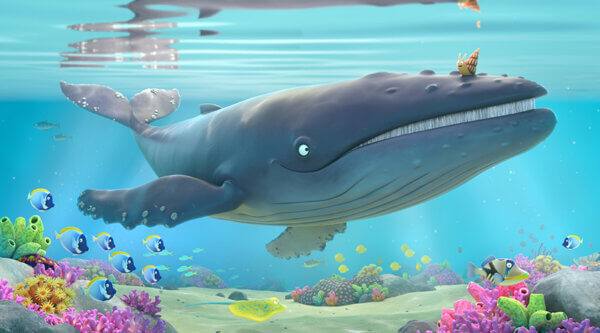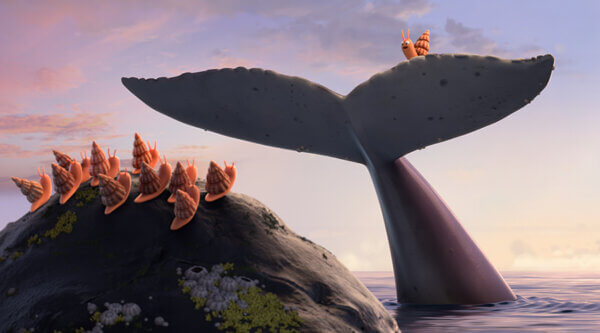‘The Snail and the Whale’ – Q&A with directors Max Lang and Daniel Snaddon
An award-winning production and distribution company dedicated to imaginative and entertaining films for international audiences, Magic Light Pictures has been responsible for some of the most talked about and warmly-received children’s picture book adaptations since their enormously popular 2009 adaptation of Julia Donaldson and Axel Scheffler’s The Gruffalo. Subsequent adaptations have included Room on the Broom, Stick Man, The Highway Rat and the two-part special Roald Dahl’s Revolting Rhymes, with accolades including four Oscar® nominations, two BAFTAs®, two International Kids Emmy® awards, a Rose d’Or® award, three Cristal® awards from Annecy International Animation Festival and many more.Their seventh Donaldson/Scheffler adaptation The Snail and the Whale is a celebration of the wonderful richness and diversity of our natural world.
The Snail and the Whale follows the amazing journey of a tiny snail who longs to see the world and manages to hitch a ride on the tail of a friendly humpback whale. A joyous, empowering story about the natural wonders of the world and discovering that no matter how small you are, you can make a difference.
Since its original BBC broadcast the film has been performing strongly on the international festival circuit, including wins at the British Animation Awards and New York International Children’s Festival, and is among the longlisted animation shorts in contention for this year’s Oscar nominations. Skwigly spoke with directors Max Lang and Daniel Snaddon to hear their reflections on the film and Magic Light’s successful track record.
To begin with – Max, can you tell us a bit about your path to animation leading up to your work with Magic Light Pictures?
ML: I wanted to work in animation since I was 12 years old. But the whole industry changed while I was in film school. I started learning traditional animation with pencil and paper while all major studios pivoted to CG animation. Luckily I realised soon enough that draftsmen and storytellers were still high in demand. Jakob Schuh was one of my mentors at the Filmakademie, and we soon became friends as we shared that love for drawing, design and storytelling. When he asked me to direct the Gruffalo with him I jumped at that opportunity.

Daniel Snaddon (Magic Light Pictures)
Daniel, your previous work with Magic Light includes 2015’s Stick Man. Was this your first role at the studio, and how to come to be involved with them overall?
DS: I first came to Triggerfish in 2012 to work as an animation lead and story artist on their indi-feature Khumba, and was helping out with some development work on another project when Triggerfish was in talks with Magic Light to make Stick Man. I just happened to be in the right place at the right time!
Had the two of you worked together before this project, either as co-directors or in other capacities?
DS: Max had written the first adaptation of Stick Man that Jeroen and I worked off of, and (I remember I contacted Max asking for some advice on how to be a good co-director, and he wisely answered we should try not to give the team too much contradictory information!), and we had both made contributions to Revolting Rhymes but we only really started working together properly on Zog.

Max Lang (Magic Light Pictures)
As a directorial duo can you talk us through your working process and the benefits of collaborating when it comes to a project such as this?
DS: I really loved working with Max. Not only does he have a wonderful imagination and a very clear vision, but he has approached each film with a generous spirit that invites genuine collaboration, which has been extended not only to me but the entire team.
In this way, I think our process has been really focused on trying to bring out the best in the team by arming them with as much good information as possible up front. We’ve found that if the different supervisors really understand the film we are making, they’re able to find ways to push the work beyond our expectations, which was a constant source of surprise and delight on Snail and the Whale!
ML: That feeling is mutual! Directing animated films takes a lot of time and it is much more fun if you have someone to share the ups and downs of that process with.
We don’t really split tasks. Each of us reviews everything, but then we compare notes and make sure that we don’t give contradictory directions to the team.
The Snail and The Whale continues a tradition of Julia Donaldson/Axel Scheffler adaptations. Although Magic Light has adapted other authors’ work what would you say are the key ingredients of what makes your collaborations with Julia in particular so successful?
DS: I think one of the real pleasures is that in doing a half-hour special as opposed to a feature, we have the luxury of staying very true to Julia and Axel’s books. This reduces the risk of losing the magic that’s there in the original, and instead presents us with a very specific set of problems that we need to solve (eg: how to create a connection between a Snail and a Whale when we’re not going to add any extra dialogue!).
To what extent does Julia have a role in the process of making the film adaptations of her work, and does that role change at all from project to project?
ML: Julia and Axel both read the scripts, watch the animatics and work in progress copies of the film. Since we’re trying to stay very true to the books and rather add than change things the feedback tends to be minimal but can sometimes be surprising, but that varies from project to project. I don’t recall any surprises on The Snail and the Whale.

The Snail and the Whale (BBC/Magic Light Pictures)
Was there anything in particular about The Snail and The Whale that determined this would be the next story Magic Light would take on?
ML: I had been dreaming of making The Snail and the Whale since we started working on the Gruffalo in 2008. It’s one of my all time favourite picture books and it’s perfect for animation. It’s also been the most challenging of the films and it took a long time and experience to figure out how to make it. The water effects, the scope and scale of the world, a friendship between two characters that are vastly different in size and that hardly talk. It was really a case of the planets aligning that determined it to be the next film. We had just cracked the story, the team at Triggerfish had the experience and hunger and time to take it on, technology had caught up. If the schedule would have shifted only by a few months we would have lost that momentum.
Of course a huge part of its visual appeal is owed to the work of Triggerfish. Can you tell us a bit about your relationship with them and how you work together on a production like this?
DS: So Triggerfish is an exciting company that is constantly evolving: When I started on Stick Man back in 2014, we had to put a team together from scratch as the crew who’d made the Indi-features (Zambezia and Khumba) had mostly moved on to other projects.
By the time we made Snail and the Whale, most of the team had worked on at least one or more Magic Light film, some of them had worked on all of the previous 4.
The benefit of all their experience was most felt when almost all the HODs had to move of Snail early and onto a new feature project: We had to put together a new team of leads and supervisors who were mostly made up of young artists who’d been star players on the previous films, and they delivered in spades!

The Snail and the Whale (BBC/Magic Light Pictures)
As with prior Magic Light specials the characters are really brought to life through voice performances from beloved UK actors. What were some of the main qualities that performers Rob Brydon, Sally Hawkins and Diana Rigg brought to this world? Had you worked with any of them previously, and did you have them in mind from the outset?
DS: We were so thrilled to have had the chance to work with Dame Diana Rigg, she brought a rare combination of authority, warmth and humor to the narration that is a very difficult balance to pull off.
Rob is a consummate vocal performer, he really can do anything! The reason we thought he’d make a wonderful whale is that we needed the audience to trust and like Whale as soon as Snail meets him (or else it could feel very off to have the snail leave with this more powerful, complete stranger!). Rob pulled this off beautifully!
Sally Hawkins is a complete genius, and came prepared with a voice for a snail that was just perfect. She gave us so many wonderful options for all the sounds that describe Snail’s efforts and betray her emotions, it was a real temptation to squeeze in as many as we could!
These specials have all been very warmly received, and I expect it must be precarious to adapt an existing story that audiences will hold close to their hearts, especially if elements need to be changed to fit the medium of film. Having had direct and significant involvement in Magic Light’s previous specials have there been any lessons learned along the way (including this special) when it comes to visual development, world creation or adaptation in general?
ML: We could probably fill a book with the lessons we’ve learned 🙂
It’s been over ten years that we started working on the Gruffalo, and I’ve been involved with most of the specials in some capacity. Each of the films also came with its very unique set challenges and difficulties. So there’s the first lesson, never think the next film is going to be easier because of your prior experiences. There’s always going to be surprises and new sets of circumstances and you need to make the most of it.
We approach each project with respect and love for the source material. Rather than changing the text or the designs we try to fill the space in between the pages. This took some time getting used to. On the Gruffalo it sometimes felt very limiting. But the great thing about limitations is that they force you to think creatively. In the cause of working on these films I’ve not only learned to work with and around these unique limitations that each project brings, but actually embrace them. I love that our films have a different pace and allow moments to breath! That we get to focus on developing characters instead of changing plot! That we can focus on expanding the world of the illustrations instead of reinventing them!
As well as a positive reception through its primary broadcast platform, The Snail and the Whale has also performed strongly at international festivals. I’m curious as to the role festivals play and the value they have when it comes to projects such as this (for example, do they significantly expand your audience/studio visibility/potential for international collaboration)?
DS: I actually served as the founding director of what has become the Cape Town International Animation Festival, and what I love the most about festivals is that they give people a chance to connect and bond over a shared passion. That’s really what it’s about for me at the end of the day, getting to have cool and inspiring conversations with people, and to get fired about animation again!
See more of the work of Magic Light Pictures at magiclightpictures.com

